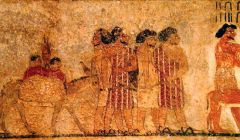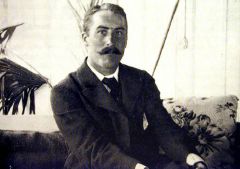![]()
![]()
![]()
Use LEFT and RIGHT arrow keys to navigate between flashcards;
Use UP and DOWN arrow keys to flip the card;
H to show hint;
A reads text to speech;
30 Cards in this Set
- Front
- Back

|
Painted wooden procession of a priest and female offering bearers, from the tomb of Djehuty-Nakht at Deir el-Bersheh, excavated by Reisner and theMFA in 1915. Dynasty 11. |
|

|
(Neb-hepet-re) Mentuhotep seated statue from the “Bab el-Hosan” (chamber at end of long passageway under the temple). Dynasty 11. |
|

|
Wooden model estate of Meket-re as found by the Metropolitan Museum expedition under Herbert Winlock (review of cattle and livestock by Meketreand his scribes). Dynasty 11. |
|

|
Granite statue of the noblewoman Sennuwy , wife of Hep-djefa, originally from Asyut in Middle Egypt, but discovered by Reisner and the MFAExpedition in a Kerma chieftain’s tumulus grave at Kerma, Third Cataract in Nubia. Dynasty 12, reign of Senwosret I. |
|

|
Beni Hasan, painting in the rock-cut tomb of Khnumhotep showing Asiatics. Dynasty 12. |
|

|
Mortally wounded skull of Seqenenre Tao. Dynasty 17. |
|

|
Quartzite sarcophagus C of Hatshepsut (her second of three), reinscribed for Thutmose I, now in the Museum of Fine Arts, Boston. Dynasty 18. |
|

|
Queen of Punt relief, from Hatshepsut’s temple at Deir el-Bahari, now in the Cairo Museum. Dynasty 18. |
|

|
Thutmose III offering to Amen, from the Hathor chapel of his temple beside that of Hatshepsut at Deir el- Bahari, now in the Cairo Museum. Dynasty 18. |
|

|
Quartzite sarcophagus of Thutmose III in the burial chamber of his tomb in the Valley of the Kings, KV34. Dynasty 18. |
|

|
Sphinx (“Dream”) stela of Thutmose IV. Dynasty 18. |
|

|
Grape vine ceiling, walls and columns of the subterranean chamber of Sennefer, mayor of Thebes under Amenhotep II, TT96b. One of the fewTheban burial chambers to bear decoration. Dynasty 18. |
|

|
“Colossi of Memnon” flanking the entrance to the (now destroyed) mortuary temple of Amenhotep III on the west bank at Thebes. Dynasty 18. |
|

|
Head of Queen Tiye from Amarna, now in Berlin. Dynasty 18. |
|

|
Seated representation of Amenhotep IV in the tomb of the vizier Ramose, TT55. Dynasty 18. |
|

|
Stela of the royal family, Akhenaten, Nefertiti and daughters in intimate setting, now in Berlin. Dynasty 18. |
|

|
Cuneiform letter discovered in the Amarna records office from the king of Alashiya (Cyprus) to Akhenaten, mentioning a gift of 100 talents of copperand suggesting an alliance between the two kings. Dynasty 18. |
|

|
Enigmatic erased/reused coffin from tomb KV55 in the Valley of the Kings, holding a mummy whose identity is still in dispute. Dynasty 18. |
|

|
Howard Carter (1874-1939), discoverer of Tutankhamun’s tomb in 1922. |
|

|
View into the antechamber of the tomb of Tutankhamen in the Valley of the Kings, KV62, taken in 1922. Dynasty 18. |
|

|
Detail of Tutankhamen and Ankhesenamun (with Aten’s disk) on the gold throne found in the king’s tomb KV62. Dynasty 18. |
|

|
General view of workmen’s village and their tombs of Deir el-Medineh, looking south. New Kingdom. |
|

|
View into the tomb of Nefertari (great royal wife of Ramesses II) in the Valley of Queens, west bank at Thebes. Dynasty 19. |
|

|
Silver coffin of Psusennes I (originally Merneptah’s) from his tomb in the temple precinct at Tanis. Dynasty 21, reign of Psusennes (1040-992 B.C.). |
|

|
Bust of Montemhet as an aged official; now in the Cairo Museum. End of Dynasty 25-beginning of Dynasty 26, about 650 BC. |
|

|
The island containing Philae temple dedicated to Isis (moved to the island of Agilkia in the 1960s due toflood waters from the Aswan High Dam). FromDynasty 30 to the Roman Period. |
|

|
The Rosetta Stone, key to the decipherment of hieroglyphs; discovered in 1799 by Napoleon’s expedition but handed over to the British in 1802 as warspoils; now in the British Museum. Trilingual decree of the ninth year of Ptolemy V Epiphanes (196 BC). |
|

|
Roman mummy portrait from Hawara, the final version of the ancient Egyptian funerary mask. Second century AD. |
|

|
Jean-Francois Champollion (1790-1832), decipherer of hieroglyphs in 1822. |
|

|
Lord Carnarvon (George Edward Stanhope Molyneux, fifth earl of Carnarvon) (1866-1923), patron funding Tutankhamun’s tomb excavation. |

